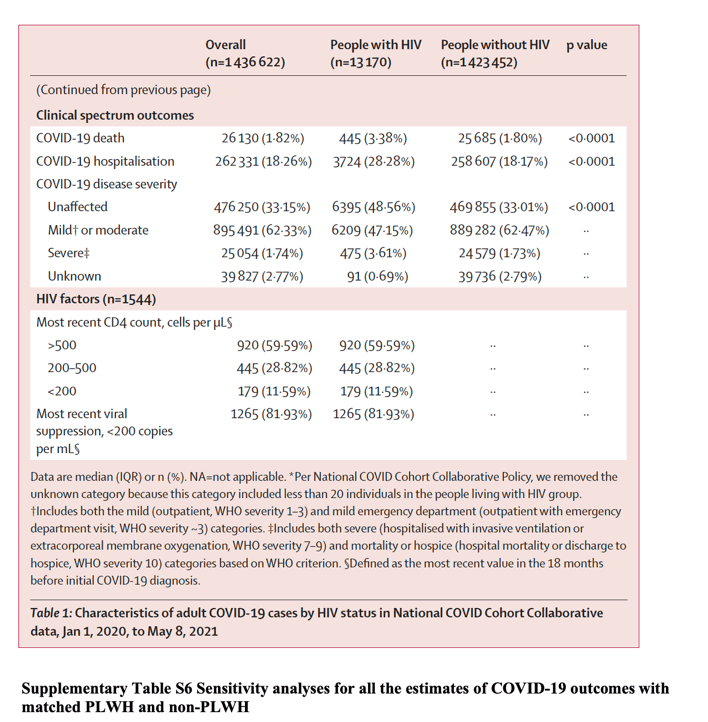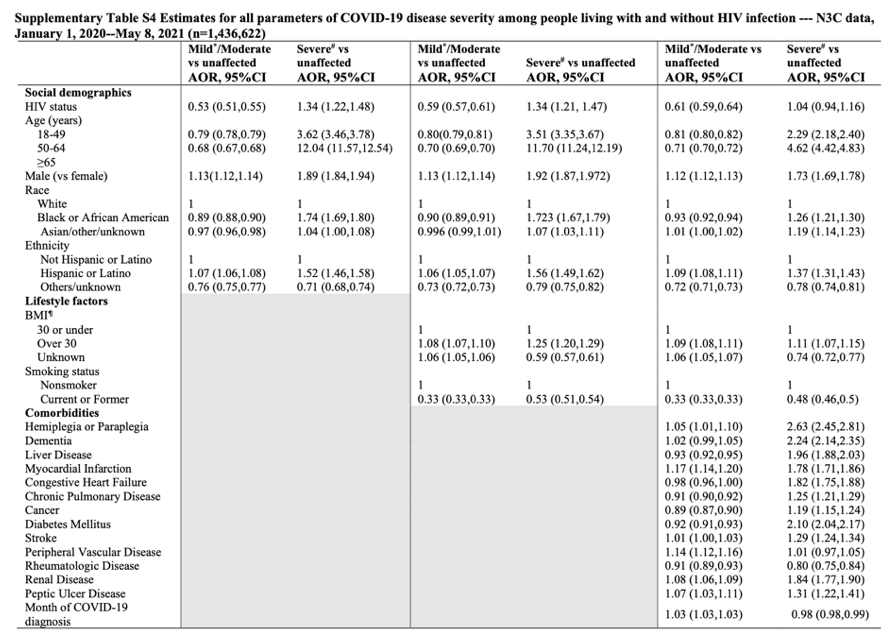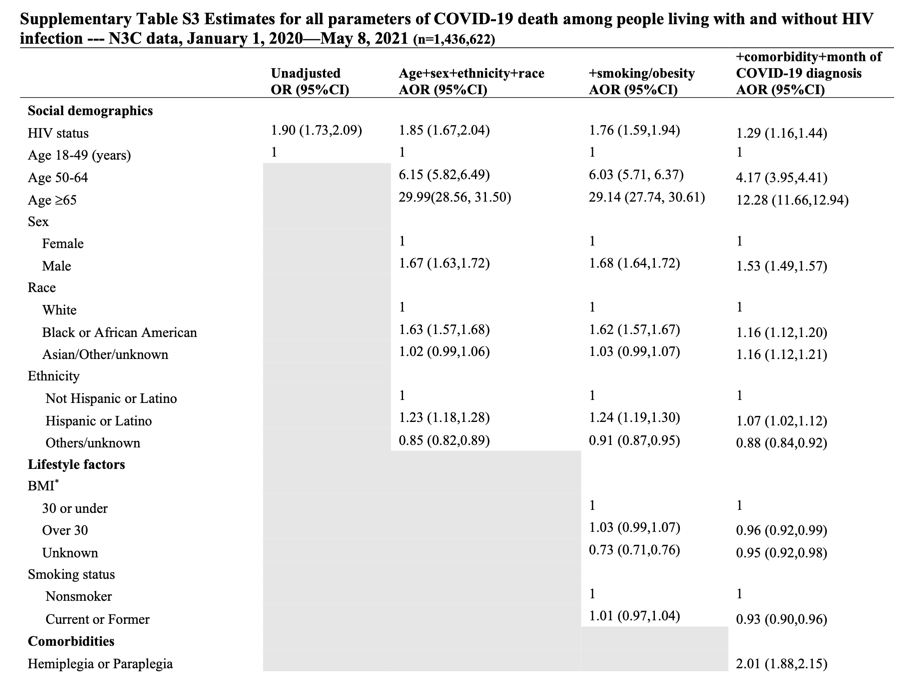| |
Associations between HIV infection and clinical spectrum of COVID-19:
a population level analysis based on US National COVID Cohort
Collaborative (N3C) data
|
| |
| |
Download the PDF here
• people with HIV had higher odds of COVID-19 death (adjusted odds ratio 1⋅29, 95% CI 1⋅16-1⋅44) and hospitalisation (1⋅20,
• Interaction terms revealed that the elevated odds were higher among older age groups, male, Black, African American, Hispanic, or Latinx adults. A lower CD4 cell count (<200 cells per μL) was associated with all the adverse COVID-19 outcomes, while viral suppression was only associated with reduced hospitalisation.
Lancet HIV October 13, 2021 - Xueying Yang*, Jing Sun*, Rena C Patel, Jiajia Zhang, Siyuan Guo, Qulu Zheng, Amy L Olex, Bankole Olatosi, Sharon B Weissman, Jessica Y Islam,
Christopher G Chute, Melissa Haendel, Gregory D Kirk, Xiaoming Li, for the National COVID Cohort Collaborative Consortium
Summary
Background
Evidence of whether people living with HIV are at elevated risk of adverse COVID-19 outcomes is inconclusive. We aimed to investigate this association using the population-based National COVID Cohort Collaborative (N3C) data in the USA.
Methods
We included all adult (aged ≥18 years) COVID-19 cases with any health-care encounter from 54 clinical sites in the USA, with data being deposited into the N3C. The outcomes were COVID-19 disease severity, hospitalisation, and mortality. Encounters in the same health-care system beginning on or after January 1, 2018, were also included to provide information about pre-existing health conditions (eg, comorbidities). Logistic regression models were employed to estimate the association of HIV infection and HIV markers (CD4 cell count, viral load) with hospitalisation, mortality, and clinical severity of COVID-19 (multinomial). The models were initially adjusted for demographic characteristics, then subsequently adjusted for smoking, obesity, and a broad range of comorbidities. Interaction terms were added to assess moderation effects by demographic characteristics.
Findings
In the harmonised N3C data release set from Jan 1, 2020, to May 8, 2021, there were 1 436 622 adult COVID-19 cases, of these, 13 170 individuals had HIV infection. A total of 26 130 COVID-19 related deaths occurred, with 445 among people with HIV. After adjusting for all the covariates, people with HIV had higher odds of COVID-19 death (adjusted odds ratio 1⋅29, 95% CI 1⋅16-1⋅44) and hospitalisation (1⋅20, 1⋅15-1⋅26), but lower odds of mild or moderate COVID-19 (0⋅61, 0⋅59-0⋅64) than people without HIV. Interaction terms revealed that the elevated odds were higher among older age groups, male, Black, African American, Hispanic, or Latinx adults. A lower CD4 cell count (<200 cells per μL) was associated with all the adverse COVID-19 outcomes, while viral suppression was only associated with reduced hospitalisation.
Interpretation
Given the COVID-19 pandemic's exacerbating effects on health inequities, public health and clinical communities must strengthen services and support to prevent aggravated COVID-19 outcomes among people with HIV, particularly for those with pronounced immunodeficiency.
Funding
National Center for Advancing Translational Sciences, National Institute of Allergy and Infectious Diseases, National Institutes of Health, USA.
Our population-level analysis from N3C data found that people with HIV might not be disproportionately vulnerable to SARS-CoV-2 infection but are more likely to be hospitalised and die from COVID-19, although such risk might be attenuated when other confounding factors are taken into consideration. The associations between HIV and these outcomes seem particularly pronounced among older people, males, Black or African American adults, and Hispanic or Latinx adults. Among people with HIV, we find that the risks for poor COVID-19 outcomes are much higher among those with lower CD4 cell counts (<200 cells per μL) and an association between viral suppression and the COVID-19 outcome of hospitalisation. To the best of our knowledge, this is the largest population-level analysis to investigate the role of HIV infection in COVID-19 clinical spectrum across the USA.
Compared with people without HIV, those with HIV had a higher proportion of severe illness (3⋅61% vs 1⋅73%), but a lower proportion of mild or moderate illness (47⋅15% vs 62⋅47%; table 1).
Among 1544 people with HIV with both CD4 cell count and viral load data, a lower CD4 cell count (<200 cells per μL) was positively associated with all the adverse COVID-19 outcomes (ie, disease severity, hospitalisation, mortality) after adjusting for all the covariates, while viral suppression was only negatively associated with hospitalisation (table 3).
Those with HIV in the older age groups had much higher odds of death and hospitalisation than those without HIV in the same age range. As another potential modifier, male sex could also interact with HIV infection in increasing the odds of severe clinical outcomes of COVID-19, yet with a smaller magnitude. Similar results were found in the interaction of race or ethnicity and HIV status, by which Black or African American race and Hispanic or Latinx ethnicity interacted with HIV infection in developing higher odds of adverse COVID-19 outcomes. Stratified models revealed that the elevated odds were higher in the similar subgroups (eg, older age, male sex, and Black or African American race; table 2; appendix pp 12-13).
Our population-level analysis from N3C data found that people with HIV might not be disproportionately vulnerable to SARS-CoV-2 infection but are more likely to be hospitalised and die from COVID-19, although such risk might be attenuated when other confounding factors are taken into consideration. The associations between HIV and these outcomes seem particularly pronounced among older people, males, Black or African American adults, and Hispanic or Latinx adults. Among people with HIV, we find that the risks for poor COVID-19 outcomes are much higher among those with lower CD4 cell counts (<200 cells per μL) and an association between viral suppression and the COVID-19 outcome of hospitalisation.
Among 1544 people with HIV with both CD4 cell count and viral load data, a lower CD4 cell count (<200 cells per μL) was positively associated with all the adverse COVID-19 outcomes (ie, disease severity, hospitalisation, mortality) after adjusting for all the covariates, while viral suppression was only negatively associated with hospitalisation (table 3).




|
|
| |
| |
|
|
|